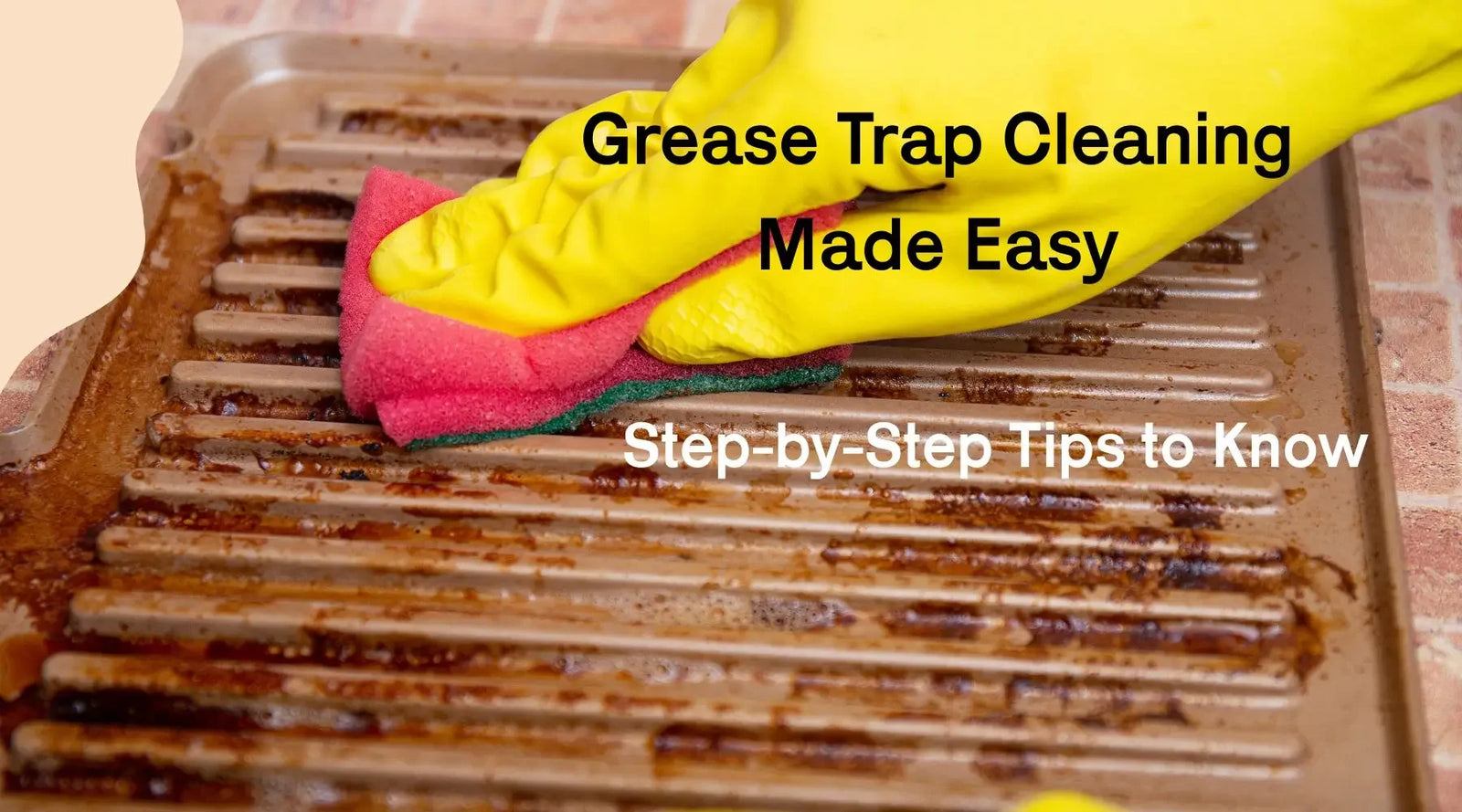Grease traps are the unsung heroes of any wastewater system—quietly working behind the scenes to keep things flowing smoothly. But when they get clogged, the mess (and the smell) can quickly spiral out of control.
The good news? Keeping your grease trap clean doesn’t have to be complicated. With the right approach and a few smart tips, you can stay ahead of buildup, avoid costly issues, and keep your system running efficiently.
Let’s break down the simple steps that make grease trap maintenance easy and stress-free.
What is Grease Trap Cleaning?
Grease trap cleaning is the process of removing fats, oils and grease. This mesh is essential in commercial kitchens and restaurants as it captures grease before it enters the plumbing system. Without regular maintenance, they clog, smell, and cause major issues.
Cleaning Grease Traps is not just about cleanliness; it is about keeping your area efficient and smell-free. Whether you are the owner of a cafe or run a high-vantage food establishment, regular cleaning ensures that your drainage system remains free and your operations are uninterrupted.
Why Regular Grease Trap Cleaning Matters?
Cleaning a grease trap isn’t just a routine; it’s a necessity. Over time, fats, oils, and grease build up and block wastewater flow. This can lead to:
- Foul odors that chase customers away
- Slow-draining sinks
- Expensive emergency plumbing visits
Restaurant grease trap cleaning is especially critical. A neglected system not only smells bad, but could also violate local health codes. The good news? Regular maintenance with the right methods and grease trap cleaning products keeps everything running smoothly.
You can also read: Grease Trap Basics: What Every Owner Should Know
What Is the Best Way to Clean Out a Grease Trap?
When it comes to cleaning a grease trap, the most effective method combines manual removal with biological treatment. Here’s how to do it right:
Step-by-Step Grease Trap Cleaning
- Turn off the water flow: Always start with safety first. Turn off the water to avoid surprises.
- Remove the lid: Use a pry bar or wrench carefully.
- Scoop out the grease: Use a small bucket or scoop to remove FOG from the top layer.
- Clean the baffles and walls: Scrub the inside with a wire brush or scraper.
- Flush with warm water: This helps remove residual grime.
- Apply a grease trap cleaner: Use a biological solution like BactoPro for long-term results.
- Reassemble and log the cleaning: Always document the date and condition.
Meet BactoPro: Your Secret Weapon in Grease Control
You can clean all day, but unless you treat the source of the problem, odors will keep coming back. That’s where BactoPro shines.
This grease trap treatment uses a high-powered blend of beneficial bacteria and enzymes. Unlike harsh chemicals, it doesn’t just mask odors—it digests the grease that causes them.
Shop Now: BactoPro
Quick-Specs: BactoPro for Grease Trap Treatment
Size: Available in 5-gallon buckets
Bacteria Count: 2 billion per dose
Application: Grease traps, drains, septic systems
Eco-Friendly: 100% non-toxic & safe for plumbing
You can also explore: How Natural Plant Fertilizer Enhances Garden Growth & Soil Health?
Benefits of Cleaning Grease Traps with BactoPro By BioPro Solutions
Chemical cleaners can be harsh. They damage pipes and the environment. Instead, cleaning grease traps with natural enzyme-based solutions offers:
Key Advantages of Using BactoPro
1. Breaks Down Grease Fast
BactoPro’s potent blend of seven bacterial strains targets fats, oils, and grease at the source—rapidly digesting organic waste for cleaner, clearer systems.
2. Naturally Eliminates Odors
By breaking down volatile fatty acids, BactoPro neutralizes foul smells, leaving your facility fresh and odor-free without chemical masking agents.
3. Works in Tough Conditions
Formulated with resilient bacteria that thrive in high-fat, low-pH environments—perfect for demanding commercial grease traps.
4. Safe and Eco-Friendly
Non-toxic and biodegradable, BactoPro is safe for all plumbing and septic systems, making it a responsible choice for businesses and the environment.
5. Long-Lasting, Cost-Saving Performance
See noticeable results in just a week. With bacteria that multiply every 20 minutes, a single 5-gallon bucket can keep your system running smoothly for up to a month, cutting down on plumbing costs.
You can also explore: Organic Fertilizer for Plants: Eco-Friendly Choices
Effortless Grease Trap Maintenance with BactoPro
Let’s be honest, nobody enjoys dealing with grease traps. They’re messy, smelly, and expensive to clean out. But with BactoPro, maintaining your grease trap can actually be easy, affordable and hands-free.
So, how does it work?
BactoPro is full of carefully chosen, grease-loving bacteria. When you add it to your grease trap, these tiny microbes get to work immediately eating away at the fats, oils, and grease that usually cause all the problems.
Here’s the amazing part: these bacteria double in number every 20 minutes when they’re feeding on grease. That means as more grease enters your system, more bacteria show up to break it down. They naturally balance themselves with the amount of grease present, so the system practically runs itself.
They work around the clock, 24/7, breaking down buildup and keeping your system clean, without chemicals or heavy equipment. And as long as you’re adding grease, they’ll keep doing their job.
Getting Started Is Simple
To kick things off, we recommend starting with 2 gallons of BactoPro, then keeping things going with a small, consistent dose: just 5 ml every 2 hours.
You don’t even have to remember to do it yourself. With a simple $50 timer and dosing pump, BactoPro can be added automatically every day.
Conclusion
Grease trap issues aren’t just gross—they’re expensive. Whether you run a busy café or manage multiple locations, a consistent cleaning routine paired with smart products saves time and money.
Ready to ditch the stink and avoid emergency plumber visits? At Biopro Solution we are the one-stop source for powerful beneficial bacteria—delivering consistent, long-term performance and complete satisfaction.
Visit us and shop now!
Check out our other guide for better information at Biopro Solution Blog.
People Also Ask:
What chemical is used to clean grease traps?
Grease traps are best cleaned with enzyme- and bacteria-based cleaners, like BactoPro. These natural solutions safely break down fats, oils, and grease (FOG) without damaging pipes. Harsh chemicals like lye can be used, but they’re not eco-friendly and may harm plumbing over time.
What chemical breaks down grease?
The most effective grease breakers are enzymes and beneficial bacteria. Lipase enzymes, in particular, target fat molecules and digest them completely. Products like BactoPro use this natural method to safely eliminate grease without harsh chemicals or toxic residue.
How often should grease traps be cleaned?
Cleaning frequency depends on usage. Fast food kitchens should clean traps every 1–2 weeks, full-service restaurants every 2–4 weeks, and small cafés every 1–2 months. Using a microbial cleaner in between helps keep traps clean longer and cuts down on professional service needs.
What is the best enzyme drain cleaner for grease?
The best enzyme drain cleaner for grease is one that combines powerful bacterial strains with grease-targeting enzymes, and BactoPro stands out as a top choice.


